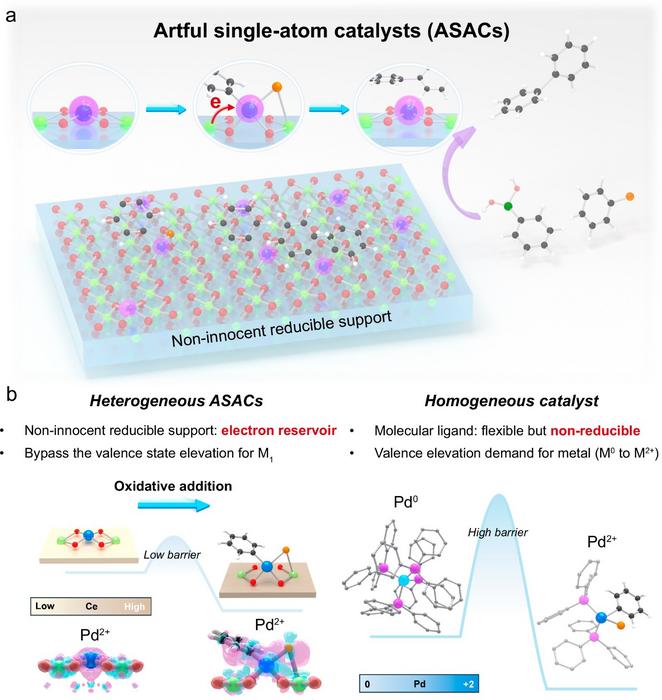Researchers at the National University of Singapore (NUS) have unveiled a groundbreaking approach in the field of catalysis with their development of an innovative class of artful single-atom catalysts (ASACs). This development is particularly pertinent in the realms of chemical synthesis and pharmaceutical applications. The NUS team, led by Associate Professor LU Jiong, has adeptly combined an “anchoring-borrowing” strategy with facet engineering techniques to surmount the traditional barriers encountered in cross-coupling reactions. Such reactions are pivotal in the manufacture of fine chemicals and pharmaceutical products, and overcoming their inherent challenges could significantly enhance industrial processes.
The crux of the ASAC approach lies in the methodical anchoring of foreign single atoms to chosen facets of reducible support materials. This strategic anchoring allows these catalysts to sidestep the cumbersome oxidative addition step that is typically associated with cross-coupling reactions. In traditional scenarios, this oxidative addition is a significant hurdle, primarily due to the energy barriers that impede reaction kinetics. By effectively bypassing this step, the NUS team has opened up new possibilities for enhancing the efficiency and selectivity of catalytic reactions.
Single-atom catalysts (SACs) have emerged as a focal point of modern catalysis. The ability of SACs to optimize the utilization of every atom in a catalytic setting, whilst also providing uniquely defined and active reaction sites, has garnered significant attention in recent years. SACs present a unique synthesis of the advantages found in both conventional and modern catalytic systems. The key lies in maintaining the stability of the metal atom while simultaneously ensuring that it remains sufficiently reactive. However, achieving this balance proves difficult, as the strong interactions often necessary between metal atoms and their supports can restrict reactivity, particularly in complex multi-step reactions such as cross-coupling.
The NUS research team’s innovative anchoring-borrowing strategy represents a leap in catalyst design. In their study, they have successfully anchored palladium (Pd) single atoms onto cerium oxide (CeO2) surfaces. This arrangement is more than just a clever configuration; it allows the material to “borrow” oxygen atoms from its environment that serve as anchor points. The role of the metal oxide as an electron reservoir is equally pivotal, as it enhances the electron flow that stabilizes the Pd atoms, preventing over-oxidation and maintaining their catalytic activity. This structural adaptability enables the ASACs to respond to the dynamic requirements of the cross-coupling reactions without succumbing to the oxidative challenges typical in such processes.
Through rigorous experimental validation, the researchers demonstrated that their Pd1-CeO2(110) ASAC exhibits remarkable performance even when employed in challenging settings, such as reactions involving aryl chlorides and more complex substrates that have historically proven difficult to react. The data gleaned from their studies underscores the superiority of the ASACs over traditional catalysts in areas such as yield consistency, reaction stability, and overall turnover numbers. This advance could redefine the standards for what is achievable in large-scale pharmaceutical manufacturing while also ensuring efficient synthesis of high-value chemical products.
The implications of this research extend broadly. Beyond just high yields in cross-coupling reactions, ASACs exhibit robust versatility. They have shown efficacy across a plethora of reactions traditionally viewed as challenging, including the Heck and Sonogashira reactions, which involve significant challenges due to the intricacies of the substrate interactions. This versatility demonstrates the profound potential of ASACs to revolutionize various areas of catalysis and chemical synthesis.
Central to the ASAC’s functionality is the dynamic structural evolution of its palladium components. The design encourages the Pd atom to constantly adapt, optimizing its geometrical and electronic configurations to facilitate reactions more efficiently. This adaptability dramatically reduces the energy requirements, further enhancing catalytic activity. Advanced methodologies such as X-ray absorption near-edge structure (XANES) analysis were utilized to confirm the stability of the palladium’s oxidation state throughout the reaction, affirming that these catalysts maintain their activity over prolonged periods.
Associate Professor LU has articulated the broader significance of this research, emphasizing that the ASACs propose a more environmentally friendly approach to the age-old challenge of oxidative additions. By transcending the limitations that beleaguer both homogeneous and heterogeneous catalytic systems, this innovation heralds a new era in chemical synthesis, with promising implications for sustainability and efficiency in pharmaceutical production.
The future trajectory of this research appears equally promising. The research team is already considering ways to extend this catalytic approach to encompass a broader array of metals applicable to cross-coupling reactions. By modifying the combinations of single atoms used and partnering them with innovative support materials, there exists potential to enhance the catalytic performance of non-precious metals, making these processes not just more efficient, but also more accessible and sustainable in the long run.
With these advancements, the research not only charts a course for improvements in chemical reactions but also provides a compelling narrative for the future of heterogeneous catalysis. The findings represented in this study form a cornerstone for developing smarter, more efficient catalysts, driving a paradigm shift that could facilitate sustainable practices across various industrial sectors. The commitment to refining and extending this technology underlines the vital role that academic institutions play in addressing the critical challenges faced in chemical synthesis today, setting a high standard for future research efforts.
In conclusion, NUS’s artful single-atom catalysts symbolize a major milestone in the evolution of catalysis, where innovative designs pave the way for unprecedented chemical transformations. As this research further matures, it stands poised to significantly contribute to the broader field of chemical manufacturing, enabling enhanced reactions that could alter the landscape of how pharmaceuticals and fine chemicals are produced.
Subject of Research: Artful Single-Atom Catalysts
Article Title: Defying the oxidative-addition prerequisite in cross-coupling through artful single-atom catalysts
News Publication Date: 4-Apr-2025
Web References:
References:
Image Credits: Nature Communications




